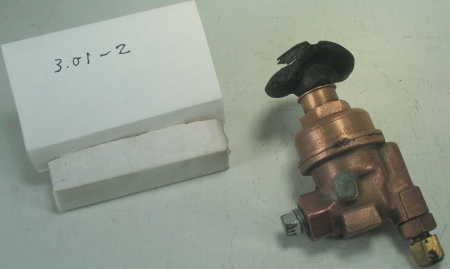Refrigerant Flow Controls – Household
An early, second generation, compact, spring compensated, adjustable, automatic expansion valve with solid, cast brass body, built-in inlet filter screen, original moisture protection cap in natural rubber, engineered for noxious sulphur dioxide, then the low pressure refrigerant of choice, Model M, American Injector, circa 1930.
Adjustment screw capped with original cap in natural rubber; Liquid line inlet screen
Technical Significance:
An example of the new generation of compact, more precisely engineered and performing expansion valves emerging early in the 1930’s, used to maintain cooling units [evaporators], in mechanically cooled refrigerators, at the desired refrigerant pressure.
Dramatises the major gains made by the industry over a period of less than 5 years, during a period of feverish research and development using the scant knowledge and experience available to workers in the field at the time, compare ID # 165 to 168
This artifact of history tells the many stories of early adoption of this particular fluid flow technology, the automatic expansion valve. After a brief flurry of excitement over the use of more costly and delicate float operated devices, as a more efficient means of flow control, industry engineers would return to the automatic expansion valve in the early 30’s. But by then the automatic expansion valve would be a smaller and much more precisely calibrated and efficient device. While the automatic expansion valve was less efficient in its effective use of evaporator surface than high and low side float systems [See HHCC Series 3.01 artifacts], it had the advantage of reliability and price, as well as serviceability.
Industrial Significance:
The engineering sophistication and advancements in manufacturing, assembly and materials utilization, represented here, in contrast to ID # 1655-168 stands as a remarkable industry achievement.
Not untypical of the times, the American Injector Company stands as an early innovator in the field of refrigerant flow controls without a sustained history in the industry. A current search of the WWW reveals no such name, possibly long since evolved into another corporate identity.


